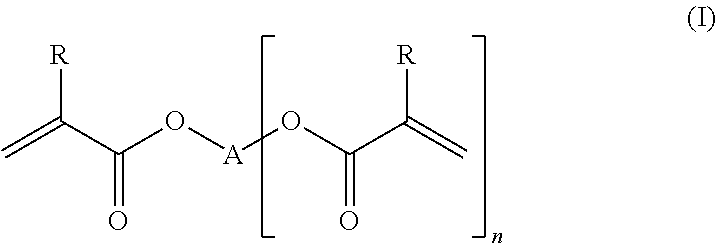Scratch-resistant-coated polycarbonates with high transparency, process for their production, and their use
- Summary
- Abstract
- Description
- Claims
- Application Information
AI Technical Summary
Benefits of technology
Problems solved by technology
Method used
Image
Examples
##ventive example 1
Inventive Example 1
Production of a Coating B1 of the Invention
[0106]2.3 g of n-butanol, 13.31 g of isopropanol, 11.40 g of ethanol, 1.61 g of Tinuvin® 400 (85% strength in 1-methoxy-2-propanol) and 5.60 g of the unsaturated, sterically hindered amine (HALS L1-1) (50.8% strength in methyl ethyl ketone) are mixed in a flat-bottomed brown glass vessel. 0.27 g of Irgacure® 819 (commercially available photoinitiator from Ciba Specialty Chemicals; bis(2,4,6-trimethylbenzoyl)phenylphosphine oxide) and 1.1 g of Irgacure® 184 (commercially available photoinitiator from Ciba Specialty Chemicals; 1-hydroxycyclohexyl phenyl ketone) are then added, with stirring. 24.02 g of Desmolux® XP 2609 (unsaturated, aliphatic polyurethane acrylate from Bayer MaterialScience AG, 70% strength in hexanediol diacrylate (HDDA), density 1.14 g / cm3, viscosity @23° C. ˜6000 mPa*s), 0.4 g Byk UV 3570 (commercially available flow-control additive from Byk-Chemie GmbH, solution of a polyester-modified acrylic-functio...
##ventive example 4
Inventive Example 4
Production of Coating B4 of the Invention
[0113]3.25 g of n-butanol, 11.4 g of isopropanol, 6.80 g of ethanol, 2.80 g of ethyl acetate, 5.47 g of sterically hindered amine L1-1 (51.6% strength in is MEK) and 6.18 g of UV absorber L2-1 (49.8% strength in MEK) are mixed in a flat-bottomed brown glass vessel. 0.27 g of Irgacure® 819 and 1.09 g of Irgacure® 184 are then added, with stirring. 9.74 g of Desmolux® VPLS 2308 (unsaturated, aliphatic polyurethane acrylate, 80% strength in hexanediol diacrylate (HDDA), density 1.11 g / cm3, viscosity@23° C. ˜29 000 mPa*s), 7.3 g SR 351 (commercially available trimethylolpropane triacrylate from Sartomer), 5.3 g of Ebercryl® 1290 (aliphatic polyurethane acrylate from Cytec, 100% strength, theoretical functionality 6, theoretical molecular weight 1000, density 1.19 g / cm3, viscosity@60° C. 2000 mPa*s), 0.4 g Byk UV 3570 (commercially available flow control additive from Byk-Chemie GmbH, solution of a polyester-modified acrylic-fun...
example 5
Production of Coating B5 of the Invention
[0114]3.00 g of n-butanol, 10.55 g of isopropanol, 6.30 g of ethanol, 2.64 g of ethyl acetate, 8.39 g of sterically hindered amine L1-2 (50.3% strength in methyl ethyl ketone) and 8.1 g of UV absorber L2-2 (58.7% strength in methyl ethyl ketone) are mixed in a flat-bottomed brown glass vessel. 0.270 g of Irgacure® 819 and 1.09 g of Irgacure® 184 are then added, with stirring. 8.4 g of Desmolux® VPLS 2308 (unsaturated, aliphatic polyurethane acrylate, 80% strength in hexanediol diacrylate (HDDA), density 1.11 g / cm3, viscosity@23° C. ˜29 000 mPa*s), 7.3 g SR 351 (commercially available trimethylolpropane triacrylate from Sartomer), is 5.3 g of Ebercryl® 1290 (aliphatic polyurethane acrylate from Cytec, 100% strength, theoretical functionality 6, theoretical molecular weight 1000, density 1.19 g / cm3, viscosity@60° C. ˜2000 mPa*s), 0.4 g Byk UV 3570 (commercially available flow control additive from Byk-Chemie GmbH, solution of a polyester-modifi...
PUM
| Property | Measurement | Unit |
|---|---|---|
| Fraction | aaaaa | aaaaa |
| Percent by mass | aaaaa | aaaaa |
| Percent by mass | aaaaa | aaaaa |
Abstract
Description
Claims
Application Information
 Login to View More
Login to View More - R&D
- Intellectual Property
- Life Sciences
- Materials
- Tech Scout
- Unparalleled Data Quality
- Higher Quality Content
- 60% Fewer Hallucinations
Browse by: Latest US Patents, China's latest patents, Technical Efficacy Thesaurus, Application Domain, Technology Topic, Popular Technical Reports.
© 2025 PatSnap. All rights reserved.Legal|Privacy policy|Modern Slavery Act Transparency Statement|Sitemap|About US| Contact US: help@patsnap.com

